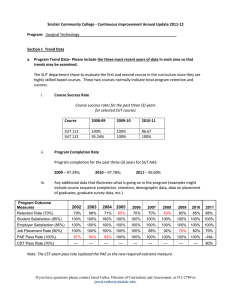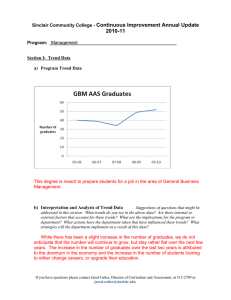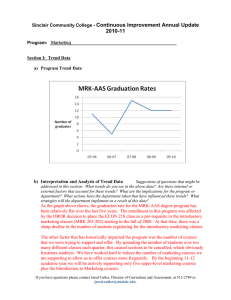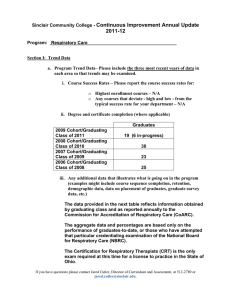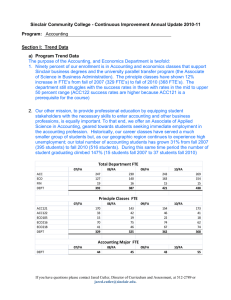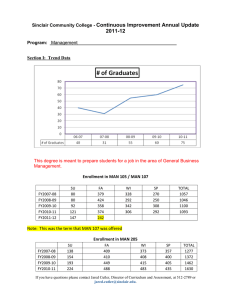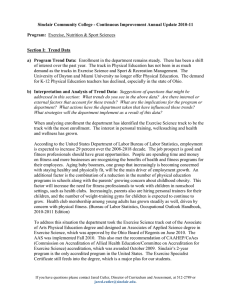Continuous Improvement Annual Update 2010-11
advertisement
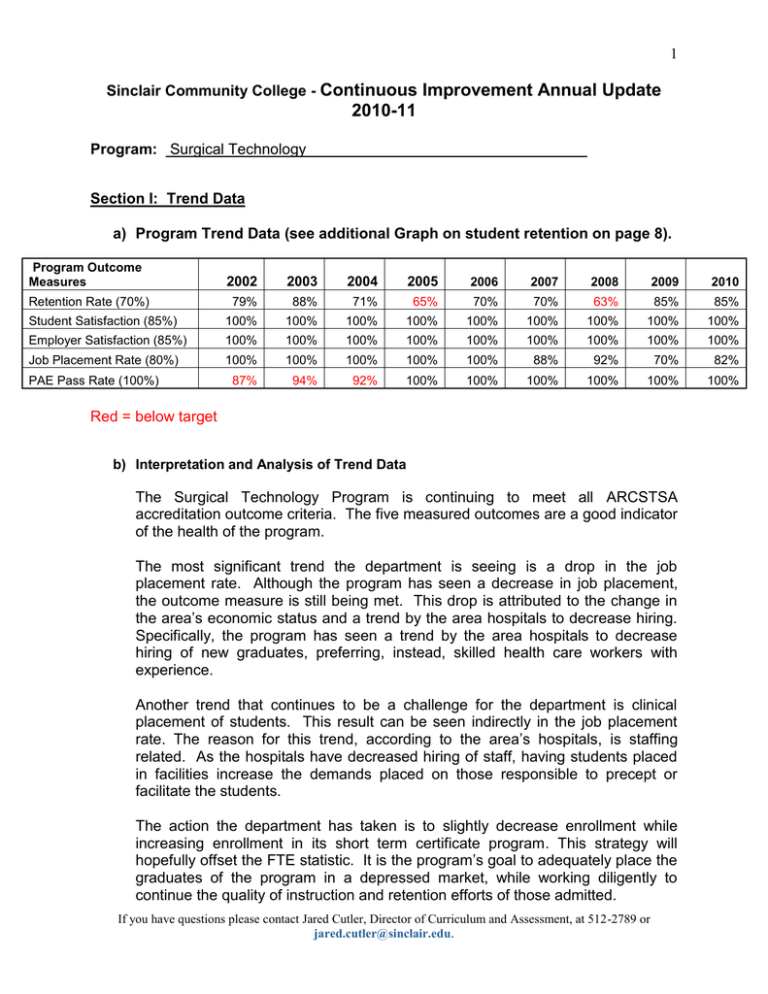
1 Sinclair Community College - Continuous Improvement Annual Update 2010-11 Program: Surgical Technology Section I: Trend Data a) Program Trend Data (see additional Graph on student retention on page 8). Program Outcome Measures 2002 2003 2004 2005 2006 2007 2008 2009 2010 Retention Rate (70%) 79% 88% 71% 65% 70% 70% 63% 85% 85% Student Satisfaction (85%) 100% 100% 100% 100% 100% 100% 100% 100% 100% Employer Satisfaction (85%) 100% 100% 100% 100% 100% 100% 100% 100% 100% Job Placement Rate (80%) 100% 100% 100% 100% 100% 88% 92% 70% 82% 87% 94% 92% 100% 100% 100% 100% 100% 100% PAE Pass Rate (100%) Red = below target b) Interpretation and Analysis of Trend Data The Surgical Technology Program is continuing to meet all ARCSTSA accreditation outcome criteria. The five measured outcomes are a good indicator of the health of the program. The most significant trend the department is seeing is a drop in the job placement rate. Although the program has seen a decrease in job placement, the outcome measure is still being met. This drop is attributed to the change in the area’s economic status and a trend by the area hospitals to decrease hiring. Specifically, the program has seen a trend by the area hospitals to decrease hiring of new graduates, preferring, instead, skilled health care workers with experience. Another trend that continues to be a challenge for the department is clinical placement of students. This result can be seen indirectly in the job placement rate. The reason for this trend, according to the area’s hospitals, is staffing related. As the hospitals have decreased hiring of staff, having students placed in facilities increase the demands placed on those responsible to precept or facilitate the students. The action the department has taken is to slightly decrease enrollment while increasing enrollment in its short term certificate program. This strategy will hopefully offset the FTE statistic. It is the program’s goal to adequately place the graduates of the program in a depressed market, while working diligently to continue the quality of instruction and retention efforts of those admitted. If you have questions please contact Jared Cutler, Director of Curriculum and Assessment, at 512-2789 or jared.cutler@sinclair.edu. 2 Section II: Progress Since the Most Recent Review a) What was the fiscal year of the most recent Program Review for this program? 2007 b) Briefly summarize the goals that were listed in Section IV part E of the most recent Program Review Self-Study (this section of the Self-Study asks “What are the department’s/program’s goals and rationale for expanding and improving student learning, including new courses, programs, delivery formats and locations”)? The department’s goals included program expansion into both pre and post graduate non-cohort tracks. This included development of new certificate programs that meet the needs of the perioperative community. c) Have these goals changed since your last Program Review Self-Study? If so, please describe the changes. The goals have not changed and the department is working to complete a new short-term certificate program in Sterilization Technology. The Surgical First Assistant certificate was put on-hold as the past three years have shown a high demand for a program by working Surgical Technologists and Registered Nurses, but a low demand for actual hiring of Surgical First Assistants by the area hospitals. However, the years 2010 -2011 has shown an increased interest by the area hospitals and surgeon groups to utilize Surgical First Assistants. The department will continue to consider this option to develop the area’s first Surgical Assistant Program. In continuing with the program’s goal of meeting the demands of the community, new opportunities have been presented. The department is working with the college and the Ohio Board of Regents to offer a new two-year associate degree in Veterinary Technology. A dedicated group of veterinarians came to Sinclair requesting such a program, and the department has taken on the role to help facilitate the group’s progress. d) What progress has been made toward meeting any of the goals listed above in the past year? As stated above. If you have questions please contact Jared Cutler, Director of Curriculum and Assessment, at 512-2789 or jared.cutler@sinclair.edu. 3 e) What Recommendations for Action were made by the review team to the most recent Program Review? What progress has been made towards meeting these recommendations in the past year? 2007 Self-Study Recommendations: 1. Document and analyze trend data of General Education outcomes across multiple sections and multiple years to identify successes and opportunities for improvements to assess the curriculum. 2. Look for ways to broaden diversity of student populations. 3. Develop appropriate assessment of impact of the hybrid admissions process. 4. Utilize existing campus resources, e.g., Service Learning, Career Services, Adjunct Faculty Services, Writing Center. 5. Work with Jennifer Kostic to develop a plan for recruiting and hiring adjunct faculty who reflect the diversity of the community. 6. Maintain existing and new connections with hospitals to ensure adequate availability of clinical sites. 7. Differentiate the position of our SUT program relative to others by marketing program quality, pass rates, cost of education, curriculum. In the past year, the department continued to monitor student progress and success in the General Education outcomes. Refinement of the program’s ‘Student Evaluation Rubric’ added more opportunities to assess critical thinking and information literacy. Increased use of student surveys is also being utilized by the faculty to monitor the student’s perception of how well critical thinking and information literacy ideas are being presented. The department continues to analyze and document the results of these initiatives. In addition, the department is actively working with its hospital liaisons to continually keep the lines of communication open regarding clinical placement and student success in the facilities. These are high priorities of the department and all outcomes measures are tied to this very important component of the Surgical Technology program. New actions have been implemented to solidify the program’s presence in the area health care facilities. These actions include quarterly meetings with key personnel in each facility to facilitate adequate and quality clinical placement. If you have questions please contact Jared Cutler, Director of Curriculum and Assessment, at 512-2789 or jared.cutler@sinclair.edu. 4 Section III: Assessment of Outcomes The Program Outcomes for this program are listed below. At least one-third of your program outcomes must be assessed as part of this Annual Update, and across the next three years all of these program outcomes must be assessed at least once. Surgical Technology Program Outcomes In which courses are these program outcomes addressed? Which of these program outcomes were assessed during the last fiscal year? Assessment Methods Used 1) Utilize critical thinking as a basis for clinical judgment and anticipatory decision making when providing perioperative care. SUT 111, 112, 211, 212, 220, 2) Demonstrate safe performance of perioperative skills. 3) Demonstrate professional behaviors of caring, accountability, responsibility, and respect for the patient’s rights of privacy, confidentiality, dignity, comfort, and quality of care. 4) Utilize effective interpersonal communication and group process skills. SUT 111, 112, 211, 212, 220; SUT 111, 112, 211, 212, 220; Preceptor / Student Evaluations SUT 111, 112, 211, 212, 220; Interpersonal and Group Skill Rubric (student self evaluation) 5) Assume the role of an involved, supportive surgical team member. SUT 111, 112, 211, 212, 220 6) Provide for physiological safety and emotional security of patient and surgical team. SUT 111, 111, 121, 121, 122 a) For the assessment methods listed in the table above, what were the results? What changes are planned as a result of the data? How will you determine whether those changes had an impact? Outcome 4 & 3 - Group discussions were more prevalent in the first SUT course for this assessment. It was important to look at communication competence as a form of both knowledge and performance. Communication competence entails knowledge of how to behave as well as actual performance. Conflict resolution scenarios were used for the assessments. If you have questions please contact Jared Cutler, Director of Curriculum and Assessment, at 512-2789 or jared.cutler@sinclair.edu. 5 A total of twelve (12) criteria or ‘messages’ were assessed by the each student after the scenario was completed. Six were positively worded in an affirmative manner (I did, I gave…), the next six were worded in a negative manner (I did not…) The students were asked to rate themselves the perception of their interpersonal communication skills. Results - The results demonstrated to the student the ‘messages’ they were sending. The scores tallied by the students gave them awareness of how they were being perceived. The students commented positively on the exercises and it will be repeated yearly in the curriculum. Across the last 3 year period, the student’s average scores on the assessment were 67%. Target was 80%. Impact - Using the knowledge from the exercises, the students commented they would implement the skills in their daily interactions with their preceptors and surgeons with whom they work. b) What other changes have been made in past years as a result of assessment of program outcomes? What evidence is there that these changes have had an impact? The change the department made was to put group discussions in the capstone portion of the program as well. This allows the department to measure the difference in scores obtained by the students in the first SUT course in comparison to the last SUT course. The Class of 2010 saw their average scores increase on the assessment from 67% to 80%, which fell within the target. The students commented their confidence had increased by being in the clinical setting and by the experiences gained in the exercise the first quarter of the program. c) Describe general education changes/improvements in your program/department during this past academic year (09-10). Written skills continue to be the department’s focus in the General Education Outcomes. The rubric provided to the student continues to be a valuable tool for both the student and faculty. Faculty have been encouraged to write comments directly on the paper instead of assigning a score only and this has helped the student improve upon general writing skills. Average paper scores have risen slightly from 73% to 83%. Target is 85%. If you have questions please contact Jared Cutler, Director of Curriculum and Assessment, at 512-2789 or jared.cutler@sinclair.edu. 6 Section IV: Improvement Efforts for the Fiscal Year a) FY 09-10: What other improvement efforts did the department make in FY 09-10? How successful were these efforts? What further efforts need to be made? If your department didn’t make improvement efforts during the fiscal year, discuss the strengths and weaknesses of the department over the last year and how the department plans to address them in the coming year. Efforts further need to be made in maintaining positive communication and working relationships with our clinical sites. The department continues to struggle with obtaining clinical sites due to market saturation of Surgical Technology students and decreased demand for health care workers in a depressed economy. The department has seen a significant decline in job placement as a result of the above stated factors. Job placement rates continued to fall since 2007 from a previous 100% job placement rate in 2000 – 2006. Job placement fell to 88% in 2007 and the average job placement rate for the years 2008, 2009, 2010 was 81%. This level meets our accreditation standard; however, the department hopes to see an increase in the job placement percentage. b) FY 10-11: What improvement efforts does the department have planned for FY 10-11? How will you know whether you have been successful? Improve upon job placement through better methods of student ‘marketing’. This will be done through utilization of ‘Student Support Services’ from the college. Interviewing skills and resume preparation will be added to the capstone course in the program Increased student job placement will be the indicator of improved marketing efforts put into place to better position the students for hire. If you have questions please contact Jared Cutler, Director of Curriculum and Assessment, at 512-2789 or jared.cutler@sinclair.edu. 7 SURGICAL TECHNOLOGY OUTCOME MEASURES 2000 - 2010 Program Outcome Measures (Targets%) Retention Rate (70%) 2002 2003 2004 2005 2006 2007 2008 2009 2010 79% 88% 71% 65% 70% 70% 63% 85% 85% Student Satisfaction (85%) 100% 100% 100% 100% 100% 100% 100% 100% 100% Employer Satisfaction (85%) 100% 100% 100% 100% 100% 100% 100% 100% 100% Job Placement Rate (80%) 100% 100% 100% 100% 100% 88% 92% 70% 82% 87% 94% 92% 100% 100% 100% 100% 100% 100% PAE Pass Rate (100%) If you have questions please contact Jared Cutler, Director of Curriculum and Assessment, at 512-2789 or jared.cutler@sinclair.edu. 8 RETENTION 1998-2010 Outcome Target = 70% 2010 2009 70% 20 70% 17 63% 19 2008 12 2007 23 70% 23 71% 16 2006 16 2005 17 64% 17 70% 11 2004 12 2003 16 2002 77% 18 20 14 1999 19 10 16 9 79% 19 14 2000 88% 18 15 2001 1998 20 17 70% 53% 56% If you have questions please contact Jared Cutler, Director of Curriculum and Assessment, at 512-2789 or jared.cutler@sinclair.edu. Started SUT 111 Graduated
